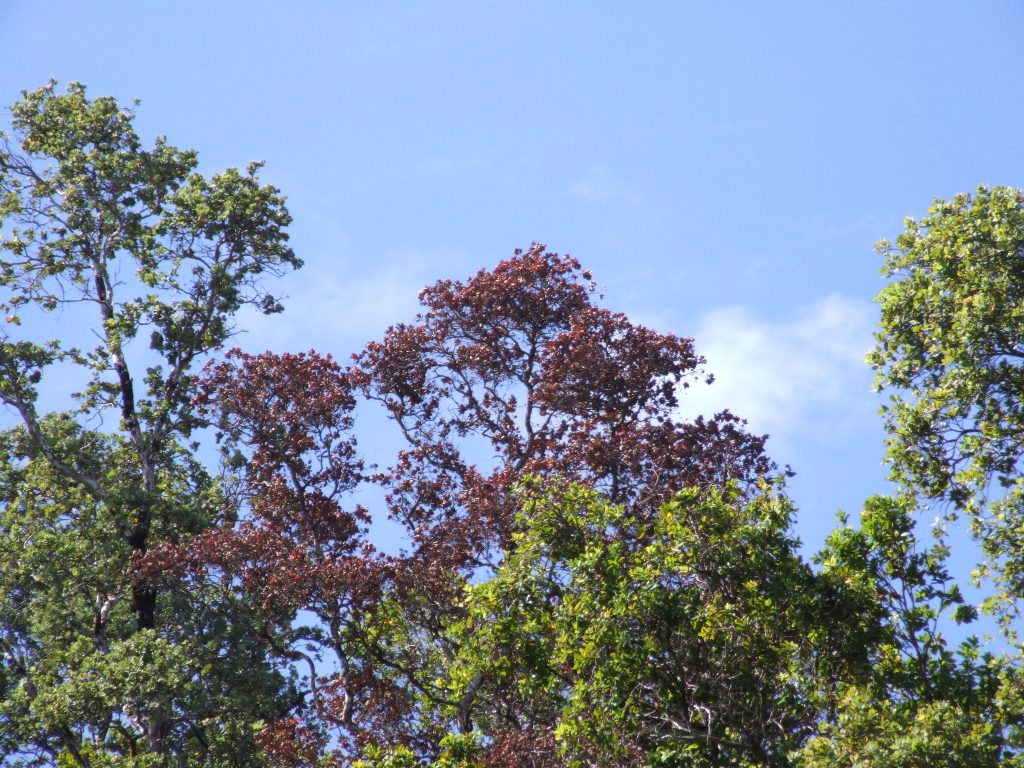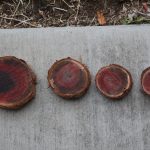Rapid ʻŌhiʻa Death (ROD)
Ceratocystis huliohia and Ceratocystis lukuohia
What is ROD? Rapid ʻŌhiʻa Death is a new fungal pathogen, that attacks and can quickly kill ʻōhiʻa trees (Metrosideros polymorpha). The disease has been recognized as two distinct species, Ceratocystis huliohia (ROD canker disease) and C. lukuohia (ROD wilt disease), with significantly different disease behavior– although both ultimately lead to tree mortality. It was first identified on Hawaii Island in 2014. ʻŌhiʻa is endemic to Hawaii and comprises approximately 80% of Hawaii’s native forests. It is a keystone species in the forest, and its loss will negatively impact watersheds, cultural tradition, natural resources, wildlife, and way of life in the Hawaiian Islands.


- Trees dead from ROD in Lava Tree State Park
- Ambrosia beetle in frass, known for spreading ROD
- Typical staining caused by ROD fungus
- ROD infected logs with characteristic staining
Photo credit above: JB Friday
C. huliohia distribution (left), C. lukuohia distribution (right):


- Regulatory Status:Hawaii State Department of Agriculture has a quarantine rule in effect. The USDA implemented the Myrtaceae Rule that restricts the movement of myrtle plants from entering Hawaii through foriegn ports.
What You Can Do:
- Don’t move ʻōhiʻa wood or ʻōhiʻa parts.
- Don’t transport ʻōhiʻa materials inter-island, including flowers, lei, untreated wood products, etc.
- Avoid injuring ʻōhiʻa.
- Clean gear and tools, including shoes and clothes, before and after entering forests. Brush all soil off of tools and gear, then spray with 70% rubbing alcohol.
- Wash clothes with hot water and soap.
- Wash your vehicle with a high pressure-hose or washer if you’ve been off-roading or have picked up mud from driving. Clean all soil off of tires, wheel wells, and undercarriage.
- Share with friends and family to prevent the spread. Follow the ROD Facebook and Instagram.
Report: Hawaiʻi Island: Only in new areas of infestation, please contact [email protected] . Neighbor islands: Report to your local invasive species committee if entire crown or major limb has turned brown within a few days or weeks:
- Kauaʻi 808-821-1490 ([email protected])
- Oʻahu 808-266-7994 ([email protected])
- Molokaʻi 808-553-5236 ext. 6585 ([email protected])
- Maui 808-573-6472 ([email protected]).
DESCRIPTION:
- Disease symptoms begin with wilting and yellowing of leaves at the end of branches.
- Symptoms of ROD include rapid browning of crowns, crowns of healthy trees browning in days to weeks is a typical symptom. (See more photos)
- Wood beneath bark will show dark staining of sapwood, this can produce a fruity smell.
- The fungus attacks the vascular system of the plant, which is the system that allows for transport of water, minerals and byproducts of photosynthesis to travel throughout the plant. When this system is blocked, the plant rapidly wilts and dies.
- “The presence of ROD can only be determined by sampling and testing the sapwood. ROD grows inside the tree, not visible on leaves or bark.” (OISC)
- “Trees within a given stand die in a haphazard pattern; the disease does not appear to radiate out directly from infected or dead trees.” (OISC)
- One way that ROD spreads is through ambrosia beetles, they spread the disease by burrowing galleries into the tree and spreading infected frass. “Frass is the sawdust and woody droppings produced by ambrosia beetles and other wood-boring insects when they bore into and colonize trees.” (UH)
IMPACTS
- Full grown mature trees can rapidly die within weeks to days after infection.
- Loss of ʻōhiʻa leads to breakdown of ecosystems, ʻōhiʻa supports and creates habitat and sustenance for many birds, insects, and understory plants.
- “The mortality rate for ROD infected trees is 100%.” (OISC)
- Loss of ʻōhiʻa will lead to a decrease in the recharge of our watersheds, ʻōhiʻa is one of the most efficient trees for collecting rainwater and mist and transferring it down into our aquifers to become drinking water.
- Loss of ʻōhiʻa has a negative impact of Hawaiʻi’s culture, being an important plant in moʻolelo (story), lei, hula, and in countless other spaces.
ERADICATION & CONTROL METHODS:
- Currently, there is no cure for trees that have been infected by the disease, due to this fact, early detection and prevention is key.
- Avoiding injuries to ʻōhiʻa is the best way to prevent the disease from spreading. “Keep lawnmowers, weed trimmers, and pruning saws away from ʻōhiʻa trees. Step over or around ʻōhiʻa roots while hiking.” (CTAHR)
- Don’t spread ROD, brush all soil and debris off of shoes, tools and equipment. After brushing, spray down after with 70% isopropyl rubbing alcohol. Allow rubbing alcohol to coat the bottom of shoes for a minimum of 15 seconds before hitting the trail.
- “There are currently no recommended fungicides (fungus-suppressing chemicals) for treating Rapid ʻŌhiʻa Death.” (CTAHR)
- Researchers are currently looking for ROD resistance trees that may already be present in the environment. Greenhouse trials have given promising results, and field trials are currently occurring. (2024)
- Fencing around forests is an effective method to keep hooved animals out, which spread ROD by damaging trees. (See Interactions Between Feral Animals and Rapid ʻŌhiʻa Death)
- College of Tropical Agriculture and Human Resources (CTAHR) – Rapid ʻŌhiʻa Death
- National Park Service – Rapid ʻŌhiʻa Death
- Hawaii State Department of Agriculture quarantine rule
- Division of Forestry and Wildlife – ʻŌhiʻa lehua
- OISC: Rapid ʻŌhiʻa Death
- A framework for establishing a rapid ‘Ōhi‘a death resistance program
- CTAHR – Education and Outreach Materials
- Arc GIS Storymap about the Interactions Between Feral Animals and Rapid ʻŌhiʻa Death




